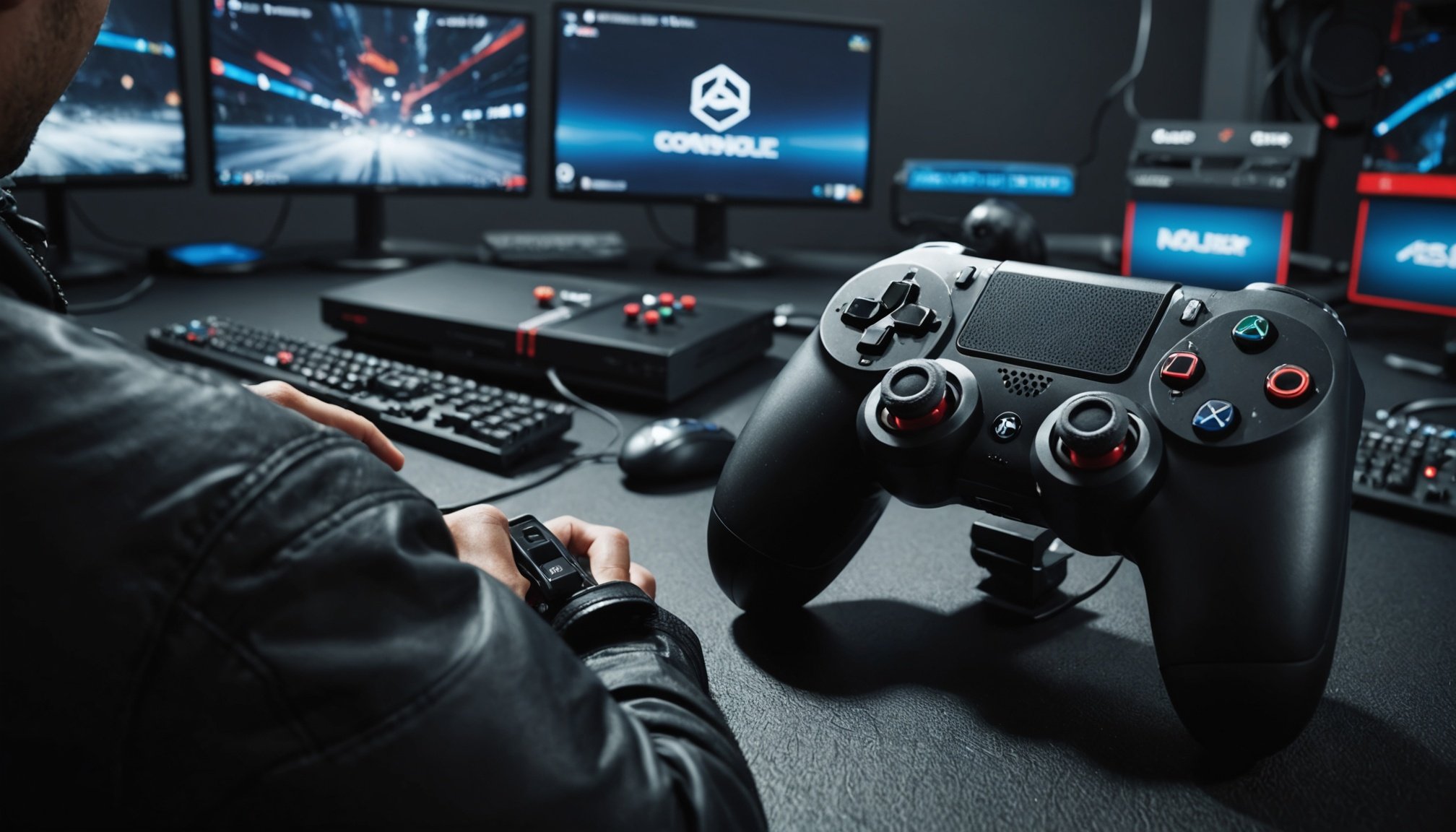Top Techniques to Reduce Input Lag in Competitive Console Gaming for Optimal Performance
When it comes to competitive console gaming, every millisecond counts. Input lag, the delay between your controller input and the on-screen response, can be a significant hindrance to your gaming performance. Here’s a comprehensive guide on how to reduce input lag and enhance your overall gaming experience.
Understanding Input Lag
Before we dive into the techniques, it’s essential to understand what input lag is and how it affects your gaming.
Also read : Essential Safety Tips for Using Virtual Reality in Mental Health Therapy Games
Input lag is the time it takes for your console to process the input from your controller and display the result on the screen. This lag can be due to various factors, including the controller itself, the console’s processing power, the display settings, and even the internet connection if you’re playing online.
Types of Lag
- Controller Latency: The delay between pressing a button on your controller and the console registering the input.
- Display Lag: The time it takes for the display to show the image after the console has processed it.
- Network Latency: The delay in online gaming caused by the time it takes for data to travel between your console and the game servers.
Optimizing Your Controller
Your controller is the first point of contact in the gaming chain, and optimizing it can significantly reduce input lag.
Also to read : Essential Factors for Crafting Intuitive Heads-Up Displays (HUDs) in FPS Games: A Comprehensive Guide
Use a Wired Connection
Using a wired connection for your controller can eliminate the latency associated with wireless connections. While wireless controllers offer more convenience, they can introduce additional delay due to signal transmission[3].
Update Your Controller Firmware
Regularly update your controller’s firmware to ensure you have the latest improvements and bug fixes. Manufacturers often release updates that can enhance the controller’s performance and reduce latency.
Choose the Right Controller
Some controllers are designed with competitive gaming in mind and have features that reduce latency. For example, the Xbox Elite Series 2 controller has a wireless connection with a very low latency, making it a popular choice among competitive gamers.
Adjusting Display Settings
Your display settings can greatly impact the input lag you experience. Here are some adjustments you can make:
Enable Game Mode
Most modern TVs and monitors have a “Game Mode” or “Gaming Mode” that reduces input lag by turning off unnecessary features like motion smoothing and reducing the display’s processing time. Make sure to enable this mode when gaming[3].
Lower Response Time
Look for displays with a low response time, typically measured in milliseconds (ms). A lower response time means the display can show changes more quickly, reducing the overall input lag.
Use the Right Sync Technology
Sync technologies like NVIDIA G-Sync or AMD FreeSync can help reduce screen tearing and stuttering, but they can also introduce some latency. However, the latest versions of these technologies are designed to minimize this latency.
Table: Display Settings Comparison
| Display Setting | Description | Impact on Input Lag |
|---|---|---|
| Game Mode | Turns off unnecessary features to reduce processing time | Lowers input lag |
| Response Time | Measures how quickly the display can show changes | Lower is better |
| Sync Technology | Reduces screen tearing and stuttering | Can introduce some latency, but latest versions minimize it |
| Refresh Rate | The number of frames the display can show per second | Higher refresh rate can reduce input lag |
| Resolution | The number of pixels on the display | Higher resolution can increase input lag if not supported by hardware |
Optimizing Console Settings
Your console settings can also play a crucial role in reducing input lag.
Use a High Refresh Rate
Ensure your console is set to output at a high refresh rate, such as 120Hz or 240Hz, if your display supports it. This can significantly reduce the time between frames and lower input lag.
Disable Unnecessary Features
Disable any unnecessary features like motion blur or dynamic lighting that can increase processing time and introduce latency.
Update Your Console Firmware
Regularly update your console’s firmware to ensure you have the latest performance enhancements and bug fixes.
Improving Your Internet Connection
For online gaming, your internet connection is critical in reducing latency.
Use a Wired Internet Connection
Similar to your controller, using a wired internet connection can reduce latency compared to Wi-Fi. Wired connections are generally more stable and offer lower latency[3].
Optimize Your Router Settings
Use Quality of Service (QoS) settings on your router to prioritize gaming traffic. This ensures that your gaming data gets the highest priority, reducing latency and packet loss.
Check Your Ping
Use tools like www.speedtest.net to check your ping and ensure it is within an acceptable range for online gaming. A lower ping time indicates lower latency.
Additional Tips for Reducing Input Lag
Here are some additional tips that can help you reduce input lag and enhance your gaming performance:
Reduce Background Applications
Close any unnecessary applications running in the background on your console. These can consume resources and increase processing time, leading to higher input lag.
Use the Best Cables
Use high-quality HDMI cables to ensure the best possible signal transmission between your console and display.
Monitor Calibration
Calibrate your monitor to ensure it is optimized for gaming. This can involve adjusting settings like brightness, contrast, and color calibration.
Practical Guide to Reducing Input Lag
Here’s a step-by-step guide to help you reduce input lag:
-
Step 1: Enable Game Mode
-
Go to your display settings and enable Game Mode.
-
This will turn off unnecessary features that can increase input lag.
-
Step 2: Adjust Display Settings
-
Set your display to the highest refresh rate supported by your console.
-
Ensure the response time is as low as possible.
-
Step 3: Optimize Controller Settings
-
Use a wired connection for your controller.
-
Update your controller firmware to the latest version.
-
Step 4: Improve Internet Connection
-
Use a wired internet connection.
-
Optimize your router settings using QoS to prioritize gaming traffic.
-
Step 5: Close Background Applications
-
Close any unnecessary applications running in the background on your console.
-
This will free up resources and reduce processing time.
Reducing input lag is crucial for competitive console gaming, and it involves a combination of optimizing your controller, display settings, console settings, and internet connection. By following the tips outlined in this guide, you can significantly enhance your gaming performance and gain a competitive edge.
As John Carmack, the legendary game developer, once said, “The best way to get started is to quit talking and begin doing.” So, take these steps, and you’ll be on your way to a lag-free gaming experience.
Final Checklist
-
Controller:
-
Use a wired connection.
-
Update firmware regularly.
-
Choose a controller designed for competitive gaming.
-
Display:
-
Enable Game Mode.
-
Set to the highest refresh rate supported.
-
Lower response time.
-
Console:
-
Update firmware regularly.
-
Disable unnecessary features.
-
Use high refresh rates.
-
Internet Connection:
-
Use a wired connection.
-
Optimize router settings with QoS.
-
Check and improve your ping time.
By following this checklist and the detailed guide above, you’ll be well on your way to reducing input lag and achieving optimal performance in your competitive console gaming endeavors.











